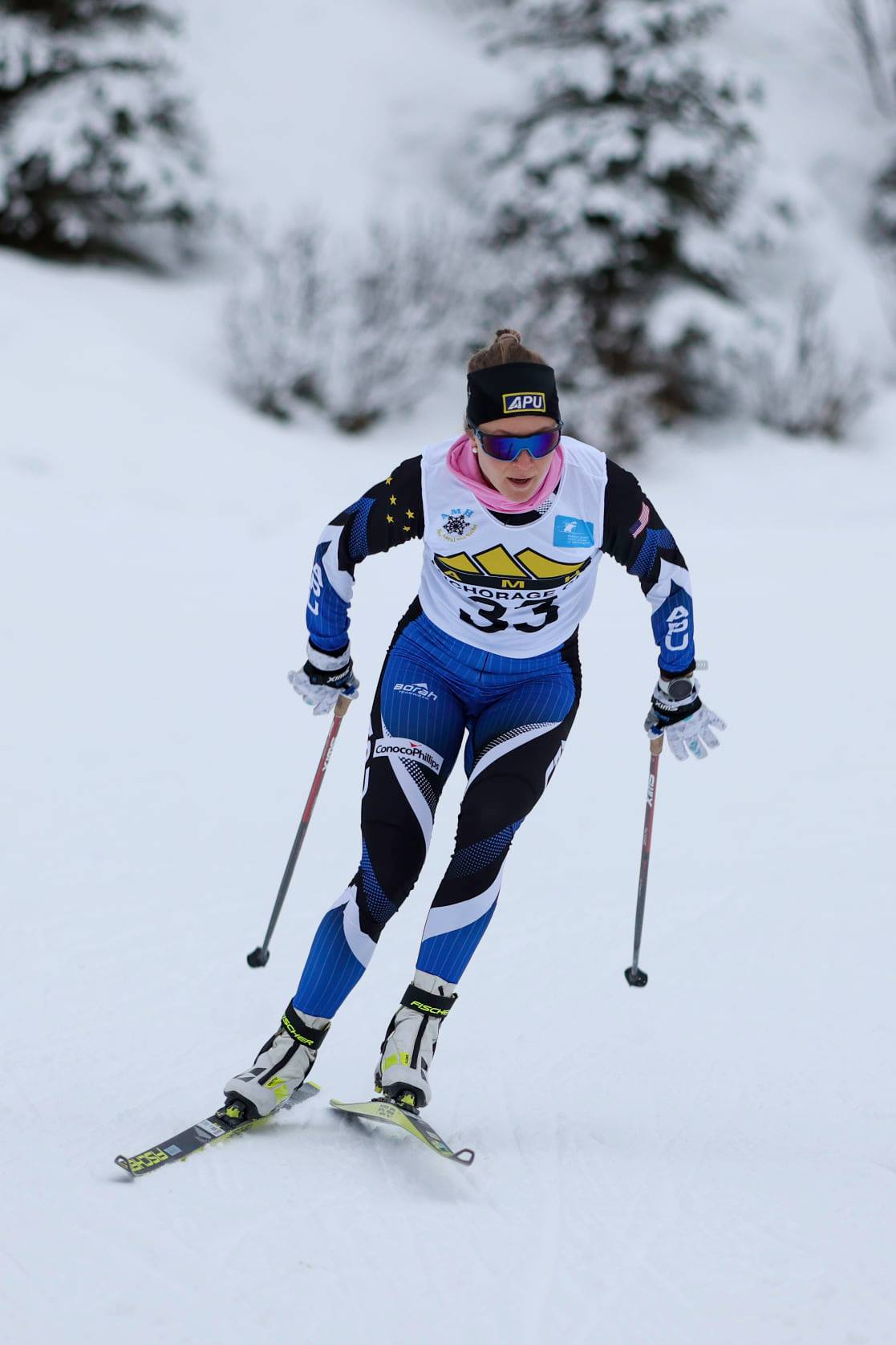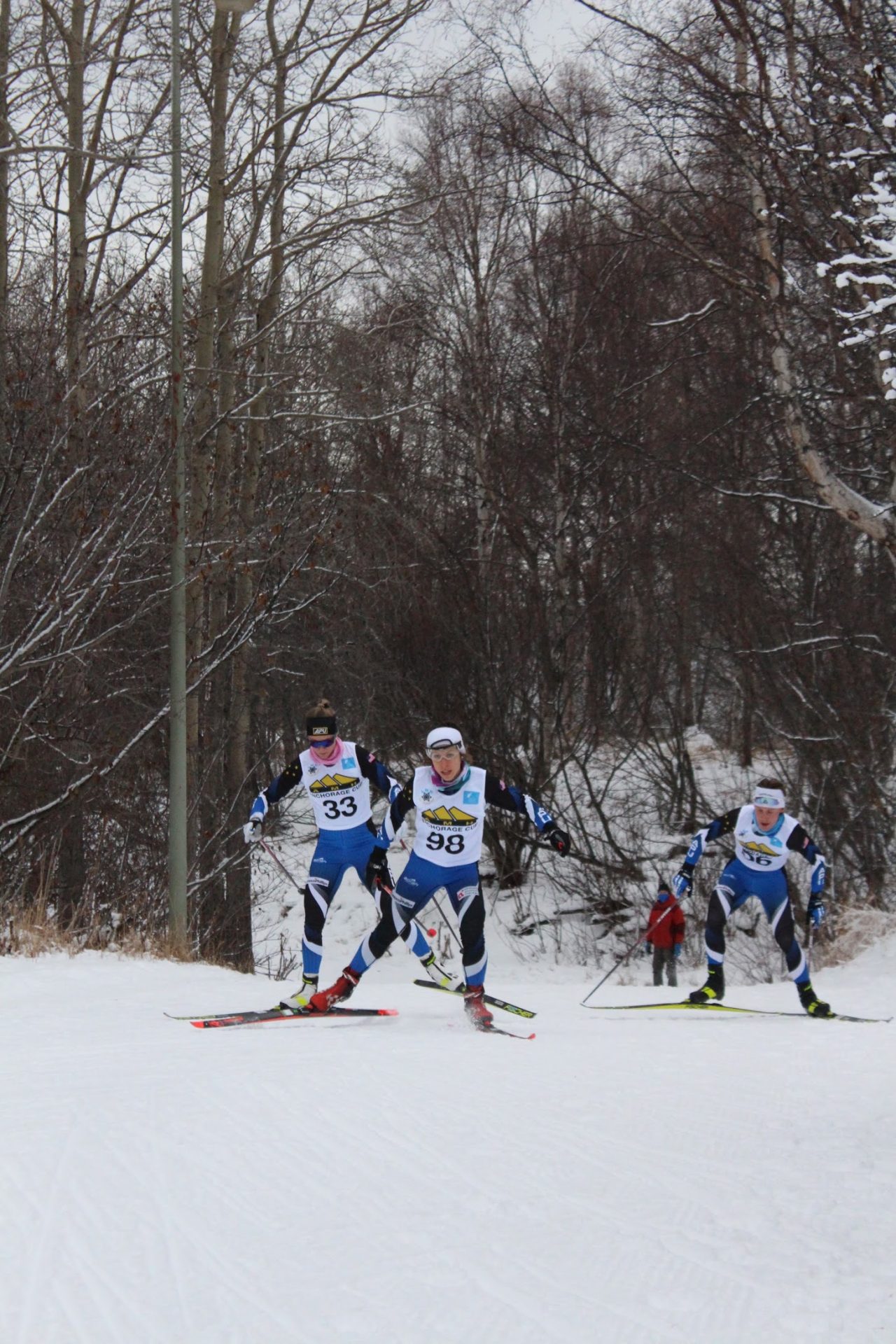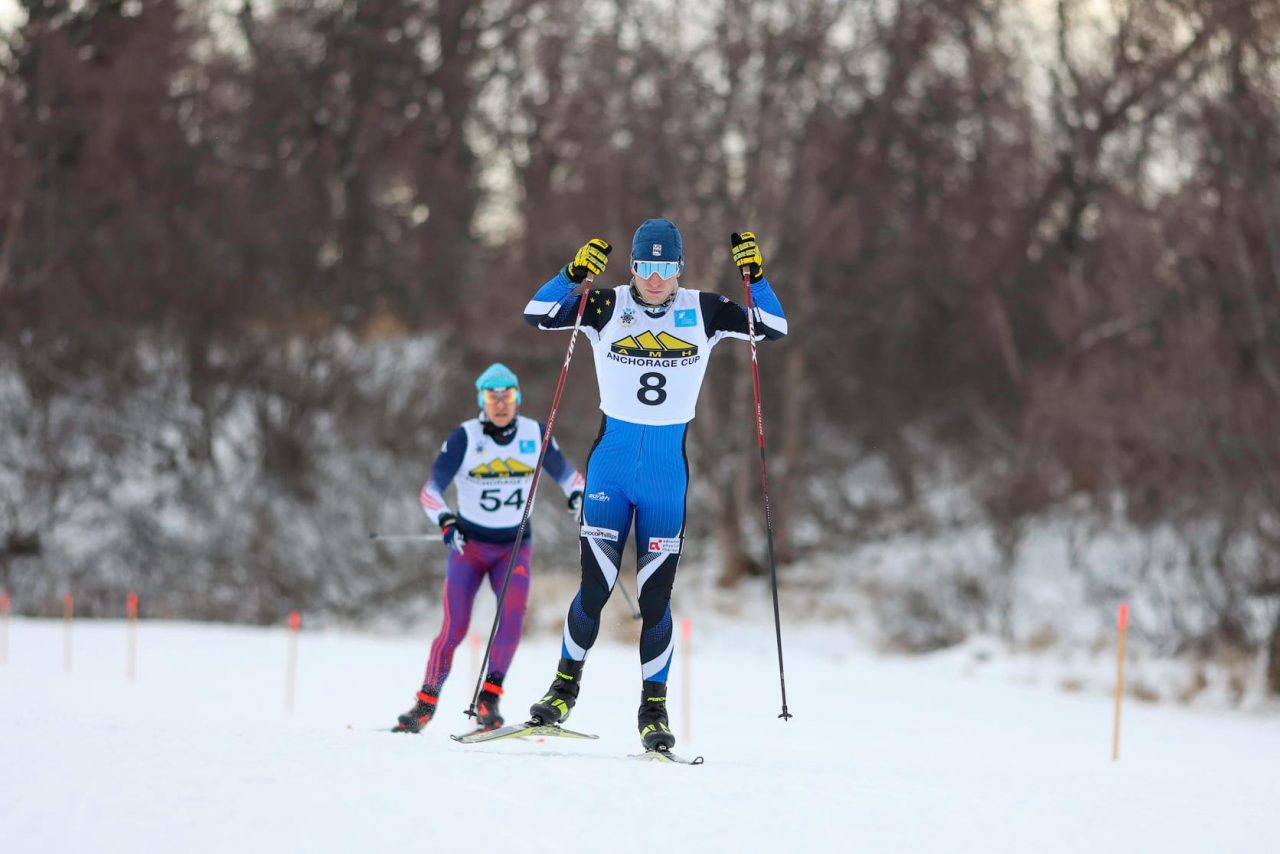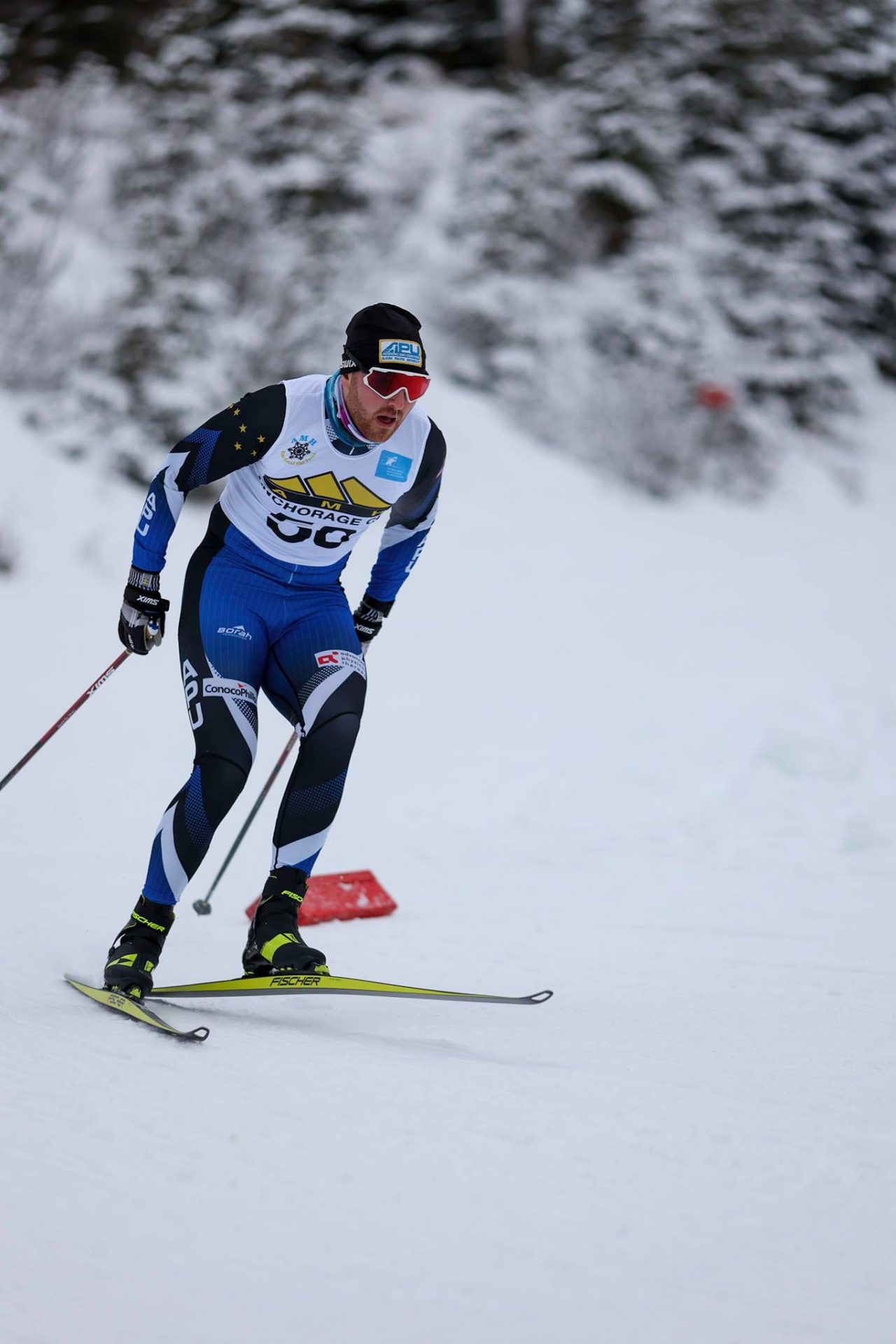
This article has been updated with additional information about the history of the Kincaid Hairpin FIS course, and with a link to an article compiling national club time trial results.
ANCHORAGE — Sunday, the second day of FIS races in Anchorage, saw, at some level, more of the same: fresh snow (though much less than the day before), soft and slow conditions, and Sadie Maubet Bjornsen at the top of the results sheet. There were some changes on the men’s side, however, as Hunter Wonders finally reached the top step of the podium this season, after coming in second in last weekend’s citizens race and third in Saturday’s sprint qualifier.
Women’s race
Sadie Maubet Bjornsen did seven 10 k skate races on the World Cup last year. (Okay, eight if you count the Tour de Ski final climb up Val di Fiemme, which is in fact also a 10 k, but that has a 418m max climb, and so has been discarded as an outlier for this point about comparing times across more typical courses.) The fastest took her 23:41, albeit on a 9.4-k course. The slowest took her 29:33, on what was actually a 10.8-k course given the precise combination of laps used.
Two laps of the hardest 5 k FIS course at Kincaid is actually closer to 10.4 k… but nonetheless, Sunday marked Maubet Bjornsen’s slowest 10 k in years, non-Tour de Ski final climb division, as she finished in 30:58.45. And she won by over a minute. It was slow going out there. (If you go back far enough: When Maubet Bjornsen, at the time 20 years old and named Sadie Bjornsen, raced this course at 2010 Senior Nationals, she was even slower, finishing 19th in 31:36.9, nearly 3 minutes back of Kikkan Randall.)
If you’ve done a senior-level distance race at Kincaid in the past decade (exception: distance races at 2018 Senior Nationals), you’ve likely raced on the Hairpin FIS course. As UAF skier Kendall Kramer said in a pre-race Instagram story about the course profile, “I don’t really understand it, but it’s like all up and no down, so that’s good.”

Also good: Maubet Bjornsen’s physical and mental shape, after, for the first time in her career, staying home in Alaska during the first part of the World Cup season.
As she wrote to FasterSkier on Sunday, “These last few weeks as I have gotten to train twice a day, mostly in the dark (December in AK), I find myself falling in love again with the sport I get to do. Generally I’m traveling all the time, trying to recover on these super challenging courses, which largely amounts to waddling around on the walls. I forgot what it feels like to ski through the woods, and ski smooth and fast, and just be in the little dream state alone in the dark. I feel like I couldn’t be luckier right now!”
Maubet Bjornsen added, “I’m so thankful for all the years of hard work I put in, and learning the circuit, because it gives me the confidence and belief to design my own plan this year. This weekend was a fun reminder that this plan was designed with a lot of thought and purpose. I’m thankful I have my teams and coaches behind me on it!”
To hear Maubet Bjornsen’s teammate tell it, this psychological comfort is accompanied by a strong physical base: “I will say that the world better watch out when Sadie gets to the World Cup,” Rosie Frankowski wrote to FasterSkier. “Yes, she might be racing small races here in Alaska, but that girl is not in local race shape. She would still be a dominant force in a strong international field so I can’t wait to see her back on the circuit when the time comes.”
Frankowski isn’t skiing that badly herself, picking up her second second-place finish behind Maubet Bjornsen in as many days (third of the season if you count last weekend’s 10 k skate). Sunday, she started second and finished second, 1:14 behind Maubet Bjornsen.
Frankowski noted that it is difficult for her to divine what her current shape is “when you aren’t racing head to head against that many people. I had some good time trials before our World Cup crew left,” she wrote, “and I have had some good races since then I think. I definitely feel that I made gains this summer in my weaknesses like coordination and speed, but, again, it is hard to tell how I would do against a World Cup field.”
Regarding her racing outlook for the rest of the winter, Frankowski observed, with equanimity, “As for myself, I might have lost the opportunity to race in Europe this year by turning down Period 1 [starts after the Lillehammer races were cancelled] so I am just going to keep focusing on what I can control, which is racing locally and enjoying the good winter we have had so far.”

Third place went to Jessica Yeaton, an Australian national who grew up largely in Anchorage and previously trained full-time with APU. Yeaton now attends school in Albuquerque, where she is in the University of New Mexico’s three-year physical therapy doctoral program, and spends far less time on snow than she used to. That said, she took time out from her studies this spring to win the American Birkebeiner in a 48-hour trip crammed in between exams, so her snow fitness remains decent.
The rest of the top ten was: Becca Rorabaugh in fourth, 2:05 back; Anna Darnell in fifth, 2:16 back; Kendall Kramer in sixth, 3:07 back; Garviey Tobin in seventh, 3:23 back; Mariel Pulles in eighth, 4:00 back; Aubrey LeClair in ninth, 5:09 back; and Marit Flora in tenth, 5:18 back. Kramer and Pulles ski for UAF; the rest of the top ten skis for APU.
The top three U18 girls were Marit Flora (APU), Meredith Schwartz (Alaska Winter Stars, or AWS), and Katey Houser (ANR).
The top three U16 girls, who skied a single lap of the 5 k course, were Sammy Legate (AWS), Amae Kam-Magruder (AWS), and Kiley Dennis (Alaska Nordic Racing, or ANR).
Men’s race
While Maubet Bjornsen destroyed the women’s field all weekend, the men saw a new name at the top of the results sheet, as APU skier Hunter Wonders took the win in 27:06.98. Wonders is currently on the USST D-Team by virtue of his top-10 finish in the 15 k classic at this year’s U23 Championships (he was eighth), which is the sort of result that would have made headline news on this site five or ten years ago, before Gus Schumacher and Hailey Swirbul et al. began destroying worlds. Wonders was second in this race at Kincaid last year (behind Schumacher), and took his first national championship in Houghton last January, in the classic sprint. Sunday’s victory appears to have been the first of his career in a senior-level FIS race (he finished behind a Canadian at nationals).

“I’m super stoked” about the win, Wonders wrote to FasterSkier. “It’s a really competitive field that we have in Alaska right now, which is fun and keeps things interesting. It’s a good confidence booster going into the rest of the season to really see that training has paid off over the last year. I’m hoping that it puts me in a good position to make the U23 World Junior team, as well as maybe get some discretionary starts on the World Cup.”
Last weekend’s winner in the 10 k skate, Zanden McMullen, was on the podium again on Sunday, this time in second, 8.66 seconds back of Wonders. Forrest Mahlen was third, 56.30 seconds back. All three men on the podium ski for APU.
The weekend marked “the first FIS races for me since the Birkie last year,” Mahlen wrote to FasterSkier. (For details on some of the intervening FIS races that didn’t happen, see this fine piece on Alaska Public Media from mid-March by FasterSkier alumnus Nat Herz, poignant headline, “This Anchorage skier flew 3,000 miles to his first World Cup race. Now he has to quarantine.”)
“It was a strange combination of remembering how to ski race, and learning how to do it safely with all of the new Covid protocols,” Mahlen continued. “The NSAA [Nordic Skiing Association of Anchorage] put together a very impressive event and I have no doubt we will have a lot more racing opportunities in Anchorage this season.”

So speaking of this season, what’s next for Mahlen? “With the uncertainty of racing at all this year my plan has been to take advantage of the amazing skiing Anchorage has had for the past nine weeks,” Mahlen wrote. “Instead of traveling and racing the Supertour I’ve been able to ski right from my front door on the APU campus onto groomed trails. With no national level racing I plan to spend the winter training far more than I usually would, and taking advantage of any local races that happen. With that in mind I was pleased with my result in the 10k today, especially with such an impressively deep men’s field for a local race.”
Mahlen noted, in reference to the national championships that would typically follow two weeks after this race weekend, “The [December] Besh Cups are usually a strong predictor of US Nationals podiums, and I don’t think that has changed this year.”
The rest of the top ten was: Thomas O’Harra (APU) in fourth, 57.30 back and just a second off the podium; Kai Meyers (APU) in fifth, 57.99 back; Sam Hendry (University of Utah) in sixth, 1:21 back; Michael Earnhart (APU) in seventh, 1:22 back; Luke Jager (APU) in eighth, 1:36 back; Magnus Norøy (UAA) in ninth, 2:11 back; and Sigurd Rønning (UAA) in tenth, 2:19 back.
The top three U18 boys were Porter Blei (ANR), Aaron Power (AWS), and Mark Eggener (AWS).
The top three U16 boys, who skied a single lap of the 5 k course, were Cole Flowers, Elias Soule, and Skyler Amy, all of Alaska Winter Stars.
Results: Skate distance races
So what comes next?
Memes, as humor often does, use comedy to express a difficult truth: This is a large country; head-to-head racing across different regions during a pandemic is ill-advised and logistically problematic (not to mention currently barred in some states); some athletes are potentially uncomfortable with the elevated role given to discretion when it comes time to select athletes for international championships.
In a mid-November email to USSS members, U.S. Ski Team Cross Country Program Director Chris Grover acknowledged the stress that race cancellations create “for athletes, coaches, parents and clubs, as they try to qualify skiers for international trips like the Oberstdorf Nordic World Championships, the World Cup, and the Vuokatti WJC/U23s.” Grover wrote, “We would like the community to know that the U.S. Ski & Snowboard coaching staff, and the various discretionary selection committees involved in selection of athletes to these trips, will now consider any type of race result that is submitted, including smaller non-sanctioned local races, and even a well-run time trial. Of course, the more professionally run the event, the easier it is to interpret the results and to weigh those results; so if official races can be run, that is ideal. But in these challenging circumstances, we want everyone to know that we will evaluate any results that you send to us for consideration. We will also continue to consider top international results from the 2019-20 season, as described in the discretionary selection criteria.”
A survey of informal time trial results this season is outside the scope of this article. (Also, it was done already, and better, on SkinnySki.) As for official races, the two Kincaid races are the first FIS races held on the continent this season, and, given their place on the calendar and the strength of their field, may be unofficially viewed as 2020/2021 U.S. Nationals West. They are the first USSS/NRL (national ranking list) competitions with results up in the MyUSSA results database. (It appears that ski races were also held this weekend for the Quarry Road Maine Cup with a few dozen athletes, though official results are not up yet, just live timing.) Races remain proscribed in Vermont, as in Minnesota. SkinnySki.com has compiled a virtual hot lap competition leaderboard for the best times on three snowmaking loops in the Minnesota area.
Racing is currently scheduled to continue in Anchorage in January with the next two races in a five-race citizens race series.
Covid reporting disclaimer: The weekend’s races occurred under the provisions of the Municipality of Anchorage’s Emergency Order No. 16 and Attachment E, which together set forth the rules governing outdoor sports competition. This includes an exception from the city’s 10-person gathering limit for outdoor sports, but bars spectators if there are more than 10 people at the venue, counting both athletes and volunteers.
This reporter watched portions of Saturday’s sprint qualifiers from home via the Kincaid stadium webcam. When he drove to Kincaid on Sunday, he found more than 10 people in the Kincaid Stadium between athletes, coaches, and volunteers (and, it must be said, a handful of spectators), and so he did not add to the total. He parked elsewhere and went skiing on other trails in a large park, then covered the races via email and Instagram direct message without needing to come close enough to anyone to stick a microphone in their face. He thanks all the athletes interviewed for their time in writing.
Gavin Kentch
Gavin Kentch wrote for FasterSkier from 2016–2022. He has a cat named Marit.
